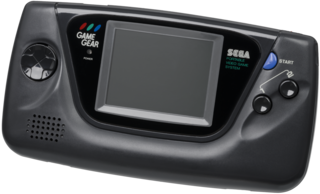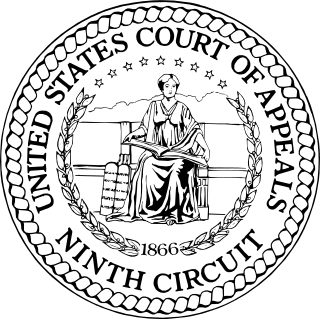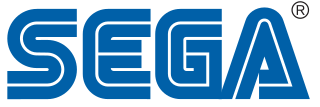Related Research Articles

The Game Gear is an 8-bit fourth generation handheld game console released by Sega on October 6, 1990 in Japan, in April 1991 throughout North America and Europe, and during 1992 in Australia. The Game Gear primarily competed with Nintendo's Game Boy, the Atari Lynx, and NEC's TurboExpress. It shares much of its hardware with the Master System, and can play Master System games by the use of an adapter. Sega positioned the Game Gear, which had a full-color backlit screen with a landscape format, as a technologically superior handheld to the Game Boy.

The Sega Master System is a third-generation 8-bit home video game console manufactured by Sega. It was originally a remodeled export version of the Sega Mark III, the third iteration of the SG-1000 series of consoles, which was released in Japan in 1985 and featured enhanced graphical capabilities over its predecessors. The Master System launched in North America in 1986, followed by Europe in 1987, and Brazil in 1989. A Japanese version of the Master System was also launched in 1987, which features a few enhancements over the export models : a built-in FM audio chip, a rapid-fire switch, and a dedicated port for the 3D glasses. The Master System II, a cheaper model, was released in 1990 in North America and Europe.
Game Genie is the name of a line of video game cheat cartridges originally designed by Codemasters and sold by Camerica and Galoob. The first device in the series was released in 1990 for the Nintendo Entertainment System, with subsequent devices released for the Super NES, Game Boy, Genesis, and Game Gear. All the devices temporarily modify game data, allowing the player to cheat, manipulate various aspects of games, and sometimes access unused assets and functions. Five million units of the original Game Genie products were sold worldwide, and most video game console emulators feature Game Genie code support. Emulators that have Game Genie support also allow a near-unlimited number of codes to be entered whereas the actual products have a much smaller limit, between three and six codes.
In the history of computer and video games, the fourth generation of game consoles began on October 30, 1987 with the Japanese release of NEC Home Electronics' PC Engine. Although NEC released the first console of this era, sales were mostly dominated by the rivalry between Nintendo's and Sega's consoles in North America: the Super Nintendo Entertainment System and the Sega Genesis. Handheld systems released during this time include the Nintendo Game Boy, released in 1989, and the Sega Game Gear, first released in 1990.
In the history of computer and video games, the third generation began on July 15, 1983, with the Japanese release of two systems: the Nintendo Family Computer and the Sega SG-1000. When the Famicom was released outside of Japan it was remodelled and marketed as the Nintendo Entertainment System (NES). This generation marked the end of the video game crash of 1983, and a shift in the dominance of home video game manufacturers from the United States to Japan. Handheld consoles were not a major part of this generation, although the Game & Watch line from Nintendo had started in 1980 and the Milton Bradley Microvision came out in 1979 though both are considered second generation hardware.
A home video game console is a video game console that is designed to be connected to a display device, such as a television, and an external power source as to play video games. Home consoles are generally less powerful and customizable than personal computers, designed to have advanced graphics abilities but limited memory and storage space to keep the units affordable. While initial consoles were dedicated units with only a few games fixed into the electronic circuits of the system, most consoles since support the use of swappable game media, either through game cartridges, optical discs, or through digital distribution to internal storage.
Tengen Inc. was an American video game publisher and developer that was created by the arcade game manufacturer Atari Games for publishing computer and console games. It had a Japanese subsidiary named Tengen Ltd..
1995 has seen many sequels and prequels in video games and several new titles such as Mario's Picross, Chrono Trigger, Mega Man 7, Rayman, Twisted Metal, Star Wars: Dark Forces, Destruction Derby and Super Mario World 2: Yoshi's Island.
1994 has seen many sequels and prequels in video games and several new titles such as Super Metroid, Donkey Kong Country and Sonic The Hedgehog 3 & Knuckles.
1993 has seen many sequels and prequels in video games and several new titles such as Star Fox, Virtua Fighter and Ridge Racer.
1992 has seen many sequels and prequels in video games and several new titles such as Super Mario Land 2: 6 Golden Coins, Art of Fighting, Super Mario Kart, and Mortal Kombat.
1990 has seen many sequels and prequels in video games and several new titles such as Metal Gear 2: Solid Snake, Fire Emblem: Shadow Dragon and the Blade of Light, Dr. Mario, and Super Mario World.
The Videogame Rating Council (V.R.C.) was introduced by Sega of America in 1993 to rate all video games that were released for sale in the United States and Canada on the Sega Master System, Genesis, Game Gear, Sega CD, and Pico. The rating had to be clearly displayed on the front of the box, but their appearance in advertisements for the video game was strictly optional. It was later supplanted by the industry-wide Entertainment Software Rating Board.
Appaloosa Interactive was a corporation, founded in 1982 in Hungary, that produced video games, computer programs and television commercials during the 1980s and 1990s. Novotrade International was founded by Andras Csaszar and Stephen J. Friedman. Csaszar served as the company's president, while Friedman served as chief executive officer. Novotrade began operating branches in the United States in 1989, and was renamed Appaloosa Interactive in November 1996. That month, the company unveiled its 10-month-old Internet technologies division, Appaloosa Online. The company's headquarters were in Mountain View, California. Appaloosa was the parent company and owner of two software development companies in Budapest, Hungary. Appaloosa was known for its Ecco the Dolphin game series for Sega. Appaloosa also developed two Contra games on the PlayStation and Sega Saturn for Konami.

The Sega Genesis, known as the Mega Drive outside North America, is a 16-bit fourth-generation home video game console developed and sold by Sega. The Genesis was Sega's third console and the successor to the Master System. Sega released it in 1988 in Japan as the Mega Drive, and in 1989 in North America as the Genesis. In 1990, it was distributed as the Mega Drive by Virgin Mastertronic in Europe, Ozisoft in Australasia, and Tec Toy in Brazil. In South Korea, it was distributed by Samsung as the Super Gam*Boy and later the Super Aladdin Boy.

Sega Enterprises Ltd. v. Accolade, Inc., 977 F.2d 1510, is a case in which the United States Court of Appeals for the Ninth Circuit applied American intellectual property law to the reverse engineering of computer software. Stemming from the publishing of several Sega Genesis games by video game publisher Accolade, which had disassembled Genesis software in order to publish games without being licensed by Sega, the case involved several overlapping issues, including the scope of copyright, permissible uses for trademarks, and the scope of the fair use doctrine for computer code.

Sega Corporation is a Japanese multinational video game developer and publisher headquartered in Shinagawa, Tokyo. Its international branches, Sega of America and Sega Europe, are respectively headquartered in Irvine, California, and London. Sega's arcade division existed as Sega Interactive Co., Ltd. from 2015 to 2020 before it merged with Sega Games to create Sega Corporation with Sega Games as the surviving entity. Sega is a subsidiary of Sega Group Corporation, which is, in turn, a part of Sega Sammy Holdings. From 1983 until 2002, Sega also developed video game consoles.
Analogue, Inc. is an American company with offices in USA and Hong Kong that designs, develops and sells video game hardware. Its hardware products include the Analogue Pocket, Analogue Mega Sg, Analogue Super Nt, Analogue Nt mini, and Analogue Nt.
References
- 1 2 3 "Chapter 7 Filing for Beeshu Inc". The Orlando Sentinel . July 31, 1995. p. 66. Archived from the original on January 31, 2021. Retrieved January 30, 2021– via Newspapers.com.
- ↑ "Press Start: Zooming Ahead with Beeshu Joysticks". Electronic Gaming Monthly . No. 1. Sendai Publications. May 1989. p. 13 – via Internet Archive.
- ↑ Snyder, Jack (June 18, 1990). "Leasing. The law firm of Bogin, Munns & Munns is doubling its space". The Orlando Sentinel . p. 31. Archived from the original on January 31, 2021. Retrieved January 30, 2021– via Newspapers.com.
- ↑ Vaughan, Vicki (August 9, 1993). "Beeshu sues Sega Enterprises". The Orlando Sentinel . p. 68. Archived from the original on January 31, 2021. Retrieved January 30, 2021– via Newspapers.com.
- 1 2 "Loan Dispute. Barnett Bank of Central Florida has filed suit against Beeshu Inc". The Orlando Sentinel . February 21, 1994. p. 76. Archived from the original on January 31, 2021. Retrieved January 30, 2021– via Newspapers.com.